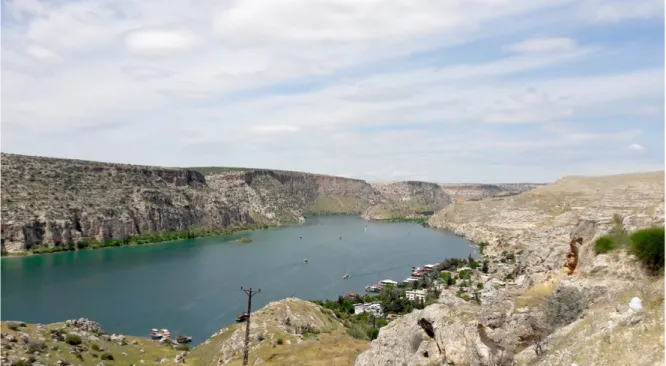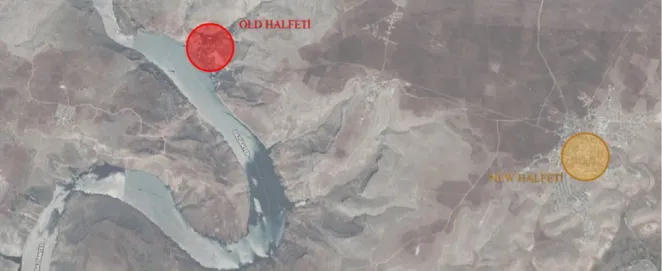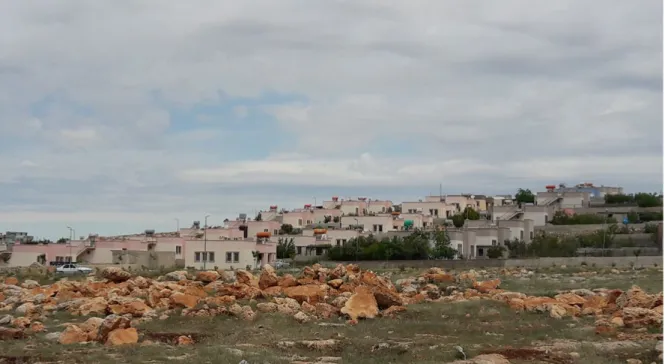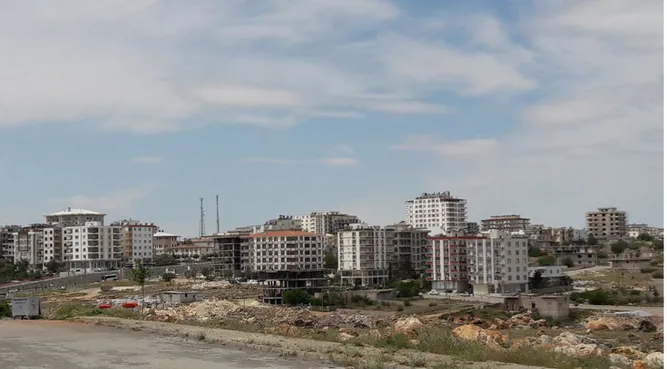ArcHistoR EXTRA 7 (2020)
www.archistor.unirc.it
ISSN 2384-8898 Supplemento di ArcHistoR 13/2020
a cura di Annunziata Maria Oteri Giuseppina Scamardì
u n pa e s e c i v u o l e
Studi e prospettive per i centri abbandonati e in via di spopolamentoo n e n e e d s a t o w n
S t u d i e s a n d p e r s p e c t i v e s f o r a b a n d o n e d o r d e p o p u l a t e d s m a l l t o w n sISBN 978-88-85479-09-8 Ayça Özmen (Cankaya University, Ankara)
Una città sommersa in Turchia: Halfeti
Halfeti, posta sulla riva dell’Eufrate, è una piccola città nel sud-est della Turchia. Il centro storico è situato sul pendio roccioso a partire dalle rive del fiume. L’architettura vernacolare segue la topografia lungo il ripido pendio. Strade strette si incurvano tra case in pietra, composte da due-tre piani con giardino, formando una composizione architettonica tradizionale. Con la costruzione della diga di Birecik nel 1999, quasi metà della città storica è stata sommersa e la maggioranza della popolazione locale fu riallocata dallo Stato in un nuovo sito. Quest’area, a 10 km dal centro storico, è stata bruscamente trasformata da zona rurale a nuovo centro della città. D’altra parte, la città vecchia si è recentemente trasformata in un’attrazione turistica, a causa di questi marcati cambiamenti e l’amministrazione comunale ne ha approfittato per trasformare nuovamente la città. In breve tempo, grazie alle strategie di sviluppo economico orientato al turismo, le case tradizionali sono state trasformate in albergo e sono stati fondati nuovi poli ricreativi e sportivi sulla riva del lago. Con l’aiuto di queste misure comunali, Halfeti nel 2013 è diventata Cittaslow. Ciò ha sembrato rivitalizzare la città, ma non ha rallentato i cambiamenti, continuando nell’abbandono delle tradizioni. In sintesi, questo lavoro, condotto attraverso la letteratura e indagini in loco, punta a sottolineare come una città si scontri con i drammatici cambiamenti provocati dalle decisioni imposte dallo Stato e come si possa riformare grazie a nuove strategie, valutandone le qualità e le criticità.
o n e n e e d s a t o w n
S t u d i e s a n d p e r s p e c t i v e s f o r a b a n d o n e d o r d e p o p u l a t e d s m a l l t o w n sAyça Özmen
Halfeti, located on the east shore of Euphrates River of Mesopotamia (fig. 1), is a small town in Southeast of Turkey. The town is comprised of 2 main settlements, Old and New Halfeti, with 646 km2
surface area and a population of 37.930 according to the Turkish Statistical Institute’s 2015 report1
(fig. 2).
Halfeti and its surroundings, in which the traces of human settlements have been seen since 1230 B.C.2, had become home to Hittites, Assyrians, Medes, Persians, Macedonians, Seleucids, Romans,
Byzantines and Ottomans respectively (Governorship of Halfeti, nd)3. Today, it is in the border of the
Republic of Turkey.
After Hittites, Assyrians are thought to have established a settlement in 855 B.C. in this region4.
In 4th century B.C., the area was under the sway of Kingdom of Macedonia. Soon after, Seleucid
Empire, Kingdom of Osroene and Roman Empire ruled over5. Romans established a settlement called
1. Halfeti Kaymakamlığı (Governorship of Halfeti), www.halfeti.gov.tr (accessed 29 March 2019). 2. Gül 2002, p. 360.
3. Halfeti Kaymakamlığı (Governorship of Halfeti), www.halfeti.gov.tr (accessed 29 March 2019). 4. Gül 2002, p. 360.
Ekamia which were called with another name as Romaion Koyla by Byzantines thereafter. In 7th and
8th century, Umayyads and Abbacies, and in 13th century Mamelukes dominated in this area. After
16th century, it came under the rule of Ottoman Empire6. Romaion Koyla was named as Rumkale
(Roman castle) by Ottomans (fig. 3). In 19th century, Rumkale was abandoned and its community
moved to opposite shore of Euphrates River where today Old Halfeti is located7. In Turkish Republic
period, Halfeti has been a town in the province of Şanlıurfa since 1954. In 1999 after the construction of Birecik Dam, large part of Old Halfeti was submerged and locals moved to another village called Karaotlak which is 10 km far from previous8. This area is, today, the new center of Halfeti.
Life in Halfeti has been radically changed along with the construction of Birecik Dam. Before Dam, it had semi-closed economy and its main source of income was pistachio cultivation. Moreover, ovine breeding, fishing, farming, fruit and vegetable growing in limited agricultural land were other means
6. Ibidem.
7. Gül 2002, p. 363. 8. Türkeli 2012, p. VIII.
of living9. The construction of dam transformed the town into a water basin and as a consequence,
the climate has changed and pistachio production has been decreased. Moreover, submerged old town has become a touristic attraction10. Tourism activities such as guest-housing, eating-drinking
facilities and water sports have been increasing day by day. Halfeti became a Cittaslow in 2013 via these municipal measures.
Traditional architecture
Historic center of town, known as also Old Halfeti, is situated on rocky slope starting from the banks of the river. Along the steep incline, vernacular architecture clambers up as being compatible to the topography (fig. 4). According to Topalan and Dağtekin, the settlement was also shaped with culture, climate, the view through river and location of caves under the houses11.
Narrow streets curving between 2-3 storey12 limestone masonry houses with courtyards form
traditional architectural composition. Traditional buildings show characteristics of the area with their local construction materials and techniques. Moreover, they are well-integrated with bed rock where they are grounded (fig. 5).
The exterior walls of the traditional houses are built with limestone, extracted from region13, by
double wall technique14. Interior walls are plastered with lath and plaster method and sometimes
there are mural paintings on these surfaces15. However, most of the houses are simple. The roofs are
flat and they are covered with pressed soil and hay16. Flat roofs were used both for house works such
as drying fruits and vegetables and for living facilities such as family gathering, relaxing and sleeping
9. Ivi, p. 11. 10. Ivi, pp. 34-36.
11. Topalan, Dağtekin 2018, pp. 355-357.
12. Ground floor and basement floor are for service units and top floors are for living facilities (Topalan, Dağtekin 2018, p. 356).
13. Akin 1999, p. 23.
14. Exterior and interior part of wall are made up of two layers of cut stones and between these layers are bridged with rubble stones. Akin 1999, p. 26; Topalan, Dağtekin 2018, p. 363.
15. Akin 1999, p. 25.
in hot summer days17. There are also courtyard walls of these inward planned houses because of
security and privacy18.
Historic center of Halfeti was declared urban protected area in 200219. Moreover, there are
twenty archeological sites and 117 registered cultural assets in and around the town20. Besides civil
architecture, a mosque dating back to the 19th century also exists (fig. 6). Other monumental buildings
17. Akin 1999, p. 25.
18. Topalan, Dağtekin 2018, p. 361. 19. Ivi, p. 354.
20. Karacadağ Development Agency 2013, p. 65.
such as historical hammam and bazaar, courtyard of the mosque, part of main square of the settlement nearby river, some houses, lots of trees and quarries of traditional houses are under water today21.
Change In Halfeti
After construction of Birecik Dam in 1999, almost half of the historic town had been submerged. In addition to the physical, ecological and economic ones, socio-cultural changes such as migration and resettlement become more of an issue in the area as a result of Dam. After Dam, majority of local people were settled in new part, known as New Halfeti, by the state.
21. Akin 1999, p. 24.
Locals did not leave only their ancestral homes but also their cultural identities and collective memories behind. At this time, in Old Halfeti, families moved out, the sources of living such as pistachio trees and river fishes have been diminishing. As a consequence of transformation from river basin to lake, habitat and microclimate of the area have changed radically, as well. Because of being deprived of daily needs and excluded from society, locals were in tendency to emigrate even if they were not affected from water level.
New Halfeti, 10 km far from old center, was transformed from a rural area to the new center of the town. Locals’ houses at old center were expropriated and land acquisition was made in this new part22. Here, state established a new built-up area for them. A grid plan composed of
single-storey reinforced concrete buildings with gardens attached to each other is far removed from locals’ conventional life styles (fig. 7). Therefore, a new social life has to be reestablished.
In New Halfeti, there are several disconnected neighborhoods. Despite, each house had unique feature in their former hometown because of different family organizations; here all houses resemble each other. Moreover, new houses were draught randomly23. Because new houses were not chosen
by users, inhabitants were not familiar to their neighbors contrary to old center. In new center, there are neither a square for gathering nor sufficient public utilities. Even, new municipality building could be built ten years after locals moved24.
Geographic factors are different than former hometown, as well. That’s why, the organization of daily life has to be adapted to new natural conditions such as badlands, new type of earth, no waterfront, no greenery, etc. New agricultural lands have to be established and cultivate by trial and error learning25.
Today in New Halfeti, some houses are yet abandoned. Some has been demolishing and new high rise apartments are built recently (fig. 8). On the other hand, because people cannot sustain their previous duties, most of them are unemployment today. Therefore, they are immigrating to other cities26.
Meanwhile, old town has turned recently into touristic attraction because of these dramatic changes. Local authorities regarded this as an opportunity to develop town once again. In record
22. Türkeli 2012, p. 33. 23. Ivi, p. 29.
24. Ivi, pp. 37-61. 25. Ivi, pp. 49-55. 26. Ivi, p. 38.
time, traditional houses were turned into guest houses, recreational activities and water sports facilities were established on lakeshore by adopting tourism oriented development strategies. Halfeti became a Cittaslow in 2013 via these municipal measures (fig. 9).
Cittaslow Halfeti
Recent globalized world has presented us speedy ways of life, growing efforts and excessive habits of consumption27. Time is equivalent to money in this context and ought to be used quickly
and effectively. Nevertheless, aforementioned accelerating tempo of life and consumption patterns
27. Parkins, Craig 2006, p. 1.
brings unhappiness and fatigue to society28 and also harms natural resources and environment at a
great pace. In other respects, Slow Movement, which emphasizes living in a sustainable, convivial, attentive and meaningful way, has emerged as a response to this trend29.
Slowness does not intend decelerating the pace of contemporary life, but rather means managing it more consciously and cautiously30. “Slow” is directly associated with time, but does not intend
realizing all in a snail’s pace. It is not, moreover, a conservative movement that refuses technology and stands up to innovation31.
The primary aim of this movement is to consciously create more time and to appreciate and feel pleasure what we are occupied in everyday life32. The most significant point is to search for “tempo
giusto,” which implies the right pace for an individual, for a case or thing, in harmony with their inner tempo33. Recently, slow movement is welcomed globally in numerous fields, for instance, city
management, gastronomy, tourism, architecture, design, etc.
One of these movements is called Cittaslow which touches on small town administration in compliance with slow principles. Cittaslow is a network of small-scale settlements with less than 50,000 inhabitants. Its International Association was established in 1999 in Orvieto (Italy) by the mayors of four Italian cities: Greve in Chianti, Bra, Positano, Orvieto. The association has extended to 264 settlements in 30 countries around the world thenceforth34.
Cittaslow offers a holistic city management program by embracing idea of Slow. It aims primarily to increase the quality of life of the inhabitants by maintaining local settlements’ values. Cittaslow also seeks for sustaining the characteristics of the town while progressing so that the inhabitants appreciate life in better habitats35.
Today, Cittaslow has become an interdisciplinary subject and is described by researchers from several fields such as a union of small-scale settlements established against standardization resulted
28. Hatipoğlu 2015, p. 20.
29. Parkins, Craig 2006; Pink 2008, p. 99. 30. Parkins 2004; Pink 2007, p. 64. 31. Honore 2008, p. 15.
32. Parkins, Craig 2006, p. 3. 33. Honore 2008, p. 40.
34. Data from November 2019, from Cittaslow International; Cittaslow International Official Website, www.cittaslow. org (accessed 29 March 2020).
by globalization, an urban social movement targeting to increase the local life quality of inhabitants by embracing Slow Food philosophy, a model for sustainable development and a policy for alternative local administration36.
Association of Cittaslow International has regulations which consist of detailed information about its principles, history, headquarters, symbol, official languages, values, national and international structures, responsibilities, funds, rights, conditions for participation and requirements for membership37. One of the charter’s most important parameters is “requirements for excellence”
which are 72 statements listed under seven main topics such as energy and environmental policies, infrastructure policies, quality of urban life policies, agricultural, touristic and artisan policies, policies for hospitality, awareness and training, social cohesion and partnerships. To enroll the association, it is essential for towns to fulfill at least 50% of these requirements38.
By providing the requirements mentioned above, Halfeti has become a slow city in 2013. Strategic decisions which local authorities took against the physical, social, economic and cultural changes had played important role for obtaining Cittaslow status. Main examples of Cittaslow projects of the town are,
- For energy and environmental policy; protecting the biodiversity of local habitat rich of various species, cultivating endemic black rose.
- For infrastructure policies; improving the roads arriving into/out of the town and the coastline, building cable suspension bridge for connecting the banks of river, enhancing the infrastructure and social reinforcement and landscaping of coastline.
- For quality of urban life policies; planning conservation development plan, preparing restoration projects for registered buildings, resurface project of Grand Mosque, street rehabilitation projects and improvement project for semi-submerged villages, conducting archeological excavation projects and building a cultural center.
- For agricultural, touristic and artisan policies; revitalizing tourism, developing eco-tourism, promoting local foods, cultivating local arts and crafts, supporting family guesthouses, developing touristic activities on water sports, encouraging fishing.
36. Özmen 2016, p. 68.
37. Cittaslow International Charter, Orvieto (İtalya), http://www.cittaslow.org/sites/default/files/content/page/ files/257/charter_cittaslow_en_05_18.pdf, (accessed 17 March 2019).
- For policies for hospitality; awareness and training, giving seminars to locals about Cittaslow and tourism.
- For social cohesion; encouraging locals coming from different ethnic roots live together, providing employment opportunity for women.
- And for partnerships; collaborating with Slow Food Association and working with UNESCO World Heritage Commission in order to be a heritage site39.
When their membership proposal analyzed using projects offered, the primary aim of Halfeti to be a Cittaslow is to recover the damaged historic area40. However, in reality, most of the projects are
today still on paper. Realized ones are predominantly tourism-oriented.
Consequences
Halfeti was a small town, located by Euphrates River for long ages. It was a traditional town where local customs, lifestyles, social pattern, and vernacular architecture had sustained. However, it has been faced with a significant change after the Birecik Dam was constructed in 1999. After that, more than a half of the settlement was flooded. Locals were settled in another village. The old center became abandoned. In a short while, local government and municipality have had willing to revitalize the town once again. The revitalization of such an abandoned town and its progress helped Halfeti be a Cittaslow association member in 2013. However, it cannot decelerate change and call its past back.
Being Cittaslow causes favorable and unfavorable outcomes in town. According to Karatosun and Çakar, for Halfeti in particular, being aware of the settlement’s cultural potencies, turning into a famous destination, increasing fiscal supports and accelerating bureaucratic processes of conservation projects can be evaluated as positive effects of this membership, however, it has backfired when negative consequences such as provisional conservation measures and expansion of tourism-oriented projects are considered41.
39. Halfeti Belediyesi (Municipality of Halfeti), www.halfeti.bel.tr [accessed 30 March 2019].; Halfeti Kaymakamlığı (Governorship of Halfeti), www.halfeti.gov.tr (accessed 29 March 2019); Cittaslow Turkey Official Website, http:// cittaslowturkiye.org (accessed 10 March 2019); Karatosun, Çakar 2017, pp. 78-80.
40. Karatosun, Çakar 2017, p. 80. 41. Ibidem.
Today, tourism seems the main tool for the town’s economic income. It is advantageous by means of local development of an abandoned town. After interventions, town has revitalized. By placing tourism functions, town has been settled again. However, these fast economic based decisions and interventions have dramatically been changing physical, social and economic structure of the town.
As Topalan and Dağtekin mentioned, tourism focused initiatives accelerate deterioration of historic fabric. Some houses are still empty and left to decay (fig. 10). Some are transformed by recent owners into tourism service areas such as pensions and commercial ventures. Some are demolished for the benefit of motorcars in order to enhance transportation system. Besides, physical structure of town changes through building out of scale architecture which does not fit to historic environment (fig. 11), installing numerous swimming restaurants on the shore of the river disconnecting the relationship between the town and river42 (fig. 12).
Locals moved out or immigrated to another towns and cities in time. New comers are mostly aiming to generate income from tourism by running restaurants, souvenir shops, guest houses, excursion boats. Once, main square of old center where locals used to practice daily routines such as meeting, ceremonies, etc., is today used for parking lots for tourist buses and cars. Nearby public toilets and souvenir kiosks are installed. Timber hitch, the symbol of town, was for crossing to opposite shore before. Today, instead, ferries and excursion boats are used (fig. 13). Moreover, a suspended bridge is recently built for connecting both shores of the town43 (fig. 14). Halfeti is visited
by mostly daily tourists who outnumber locals during day. On the other side, daily tourism makes the town depopulated during night.
Briefly, Cittaslow becomes a tool for tourism promotion rather than increasing the quality of locals’ lifestyle, particularly in Halfeti case. The town is not slow anymore but being in the trend of small town’s tourism. However, tourism is not the main goal for Cittaslow idea. Its primary aim is to increase the quality of life of inhabitants44. In this sense, tourism development caused by Cittaslow
membership can be just means for this aim. Besides, tourism-focused strategies does not only harm to essence of Cittaslow idea but also conservation of cultural and natural heritage.
Though, a livable town not only offers inhabitants better life quality but also welcomes visitors. Cittaslow can develop tourism in this way. In other words, detailed and integrated approach of Cittaslow projects, helps implicitly to develop both conservation of natural and cultural heritage, and sustainable tourism.
42. Topalan, Dağtekin 2018, p. 364. 43. Türkeli 2012, pp. 34-36. 44. Rådström 2011, p. 100.
Figure 12. Floating restaurants-Old Halfeti (photo A. Özmen, 2018).
Figure 13. Marina for ferries and excursion boats-Old Halfeti (photo A. Özmen,2018).
Bibliography
Akin 1999 - N. Akin, Güneydoğu’da Bir Son Nokta: Halfeti ve Birecik Barajı, in «Journal of Mimarlık», 1999, 290, pp. 23-28. Gül 2002 - M. Gül, Mısır Memluklarının Hudud Kalesi Rumkale ve Anadolu’da Memluk İzleri, in «Fırat University Journal of Social Sciences», 12 (2002), 2, pp. 359-366.
Hatipoğlu 2015 - B. Hatipoğlu, Cittaslow: Quality of Life and Visitor Experiences, in «Tourism Planning & Development», 12(2015) 1, pp. 20-36.
Honore 2008 - C. Honore, Yavaş, Hız Çılgınlığına Başkaldıran Yavaşlık Hareketi, translated by E. Gür, Alfa Yayınları, İstanbul 2008.
Karacadağ Development Agency 2013 - Karacadağ Development Agency (Karacadağ Kalkınma Ajansı). TRC2 Bölgesi (Diyarbakır-Şanlıurfa) Bölge Planı 2014-2023 Mevcut Durum Raporu, Temmuz, s.l. 2013, https://www.karacadag.gov.tr/ Planlama/Dosya/www.karacadag.org.tr_6_VX1P24GO_trc2_bolgesi_mevcut_durum_raporu.pdf (accessed 12 March 2019).
Karatosun, Çakar 2017 - M. Karatosun, D. Çakar, Effects of Cittaslow Movement on Conservation of Cultural Heritage:
Case of Seferihisar, Halfeti, Turkey, in «Civil Engineering and Architecture», 5 (2017), 3, pp. 71-82.
Özmen 2016 - A. Özmen, Tarihi “Cittaslow” Yerleşimlerinde Kentsel ve Mimari Koruma İlkeleri, PhD Thesis, Yıldız Technical University, Graduate School of Science and Engineering, Istanbul 2016.
Parkins, Craig 2006 - W. Parkins, G. Craig, Slow Living, Bloomsbury Academic, London 2006.
Pink 2007 - S. Pink, Sensing Cittàslow: Slow Living and the Constitution of the Sensory City, in «The Senses and Society», 2 (2007), 1, pp. 59-77.
Pink 2008 - S. Pink, Sense and Sustainability: The Case of the Slow City Movement, in «Local Environment», 13 (2008), 2, pp. 95-106.
Rådström 2011 - S.J. Rådström, A Place Sustaining Framework for Local Urban Identity: an Introduction and History of
Cittaslow, in «Italian Journal of Planning Practice», 1 (2011), 1, pp. 90-113.
Topalan, Dağtekin 2018 - M. Topalan, E. Dağtekin, A Documentation of Traditional Halfeti Houses, in «Gazi University Journal of Science», 31 (2018), 2, pp. 354-366.
Türkeli 2012, H. Türkeli, Fırat’ın Dili Olsa. Zorunlu Göç ve Yeniden Yerleşim Sürecinde Mekan - Kültür Etkileşimi: Halfeti









